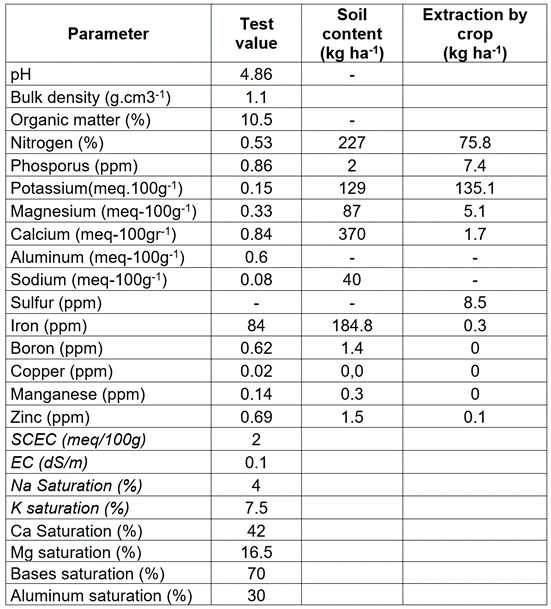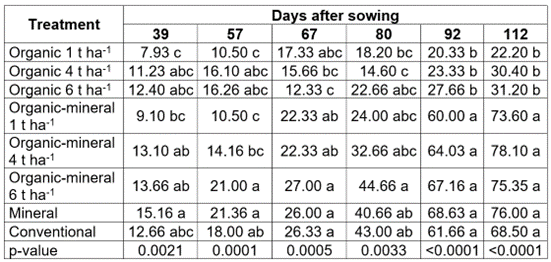INTRODUCTION
The potato, Solanum tuberosum L. is one of the main sources of food, with a worldwide production of 876,005,707 t, in 2022, just after sugarcane, maize, rice paddy and wheat. For the year 2022, the area of potato cultivation in Colombia reached about 258,517 ha (FAO, 2023), of which the diploid potato ‘Criolla’ potato (S. tuberosum) phureja group, represented approximately 7 % with exports close to 1.000 t.year-1 (FNFP, 2017). In Colombia, the name ‘Criolla’ potato corresponds to morphotypes that have tubers with yellow skin and flesh color (egg yolk phenotype).
‘Criolla’ potato is cultivated from 2.600 to 3.500 m a.s.l. with a temperature range between 10 and 20 °C (Rozo Rodríguez & Ramírez, 2011); crop yield varies according to the environmental offer, management practices, cultivars sown, and other factors. The Ministerio de Agricultura y Desarrollo Rural de Colombia MADR (2019) reports a maximum yield of 22.7 t ha-1. In Peru, the best yield reported corresponds to cv ‘Blanca amarilla’ with 27.8 t ha-1 (Seminario-Cunya et al. 2018).
Proper nutrition management requires: knowing the fertility of the soil, the total demand, and the daily rate of nutrient accumulation by the crop, which are a function of the growth rate, phenology, variety, environmental offer, and yield goal. Therefore, the profitability and environmental impact caused by fertilizers on the soil, water, and air must be considered (Sifuentes Ibarra et al. 2013).
The beneficial effect of organic manure on potato crops is known. The crops react favorably to organic fertilizers because they improve the soil structure and gradually release plant nutrients, an ideal complement for chemical fertilization (Mallory & Porter, 2007), constituting an ideal complement for chemical synthesis fertilizers. The use of farmyard manure increases the yield of crop potatoes concerning mineral nutrition and promotes soil health (Meena et al. 2019). Integrated nutrient plans including poultry manure and inorganic mineral nutrient allow obtaining the best availability of P and K, higher yields (22.86 t ha-1) and a major number of tubercles (Kafle et al. 2019).
Romero-Lima et al. (2000) evaluated different organic and mineral nutrient sources, in another group of Solanum tuberosum, and found that the complementary nutritional requirements were lower when chicken manure was applied, obtaining bigger tubers and an increase in yield.
The purpose of this study was to determine the effects of organic fertilization and its contribution to the yield and quality increase of potato tubers cv ‘Colombia’, and how the interaction with the mineral source of nutrients could enhance these variables.
MATERIALS AND METHODS
The study was carried out during January and May of a year with el niño phenomena, at the Universidad de Ciencias Aplicadas y Ambientales U.D.C.A, Bogotá, Colombia; altitude of 2.560 m a.s.l. coordinates 04°35′N 74°04′. The plant material used was potato cv. ‘Criolla’ Colombia, a clonal selection of round yellow native cultivars, which were planted at a depth of 10 cm. The crop was established in a soil classified as Andisol with a degree of evolution from low to moderate, regular to well-drained, loamy to clay loam texture, in the surface horizon and clayey, in the deepest ones The soils have moderate effective depth, limited in some cases by a fluctuating water table. The morphology of the profile shows an Ap. horizon over a Bw, being the first one of black color, due to the high percentage of organic matter and with subangular block structure, moderately developed. The second horizon is grayish brown.
The soil was amended one month before planting with a dose of 2 t ha-1 of dolomite lime to correct the acidic pH (4.86) and reduce the 30 % of aluminum saturation. The dolomite lime was applied at the bottom of the groove.
A completely random design was used with eight treatments, three replications per treatment. For measure, were evaluated 3 samples per replication. Planting density was 0.30 m between plants and 0.90 m between rows, each treatment was composed of 90 plants sowed in plots of 30 m2.
Fertilization of mineral and organic was carried out at the time of sowing and was distributed in the different treatments to be evaluated.
Eight treatments were evaluated: T1 to T3 correspond to organic treatments consisting of 3 different doses of chicken manure (organic source); T1, organic (1.000 kg ha-1); T2 organic (2.000 kg ha-1); T3 organic (6.000 kg ha-1).
T4 to T6 treatments correspond to mixed, different doses of chicken manure (organic source) and a mineral treatment with one level of mineral nutrition according to soil test (Table 1), being mineral treatment doses of 15 kg ha-1 DAP, 10.16 kg ha-1 of KCl and supplemented with 5 kg ha-1 of urea, nested with 3 levels of organic manure, T4 mineral + organic (1.000 kg ha-1); T5 mineral + organic (4.000 kg ha-1); T6 mineral + organic (6.000 kg ha-1).
T7 and T8 treatment were two hangout treatments, T7 mineral treatment with 15 kg ha-1 DAP,10.16 kg ha-1 of KCl and supplemented with 5 kg ha-1 of urea, and T8 conventional nutrition 321 kg ha-1 of multi-nutrient fertilizer 10-30-10.
Sampling was focused on the variables of growth and development of the plant. A total of 9 plants were evaluated per treatment on nondestructive measures, number, and length of stems; destructive measures were leaf area (cm2) using CID CI202 laser equipment, dry weight of shoot, and tubers (g). Samples were performed during the crop cycle at 22, 53, 73, 90, and 105 days after sowing (DAS). To determine yield, ten plants were sampled by treatment, and to recognize the quality of the potatoes, tubers’ equatorial diameters were measured by a caliper, dividing the potatoes into three categories according to local market requirements: large (4-6 cm), medium (2-4 cm), and small (<2 cm).
Data were subjected to analysis of variance (ANOVA), means comparisons were performed using Tukey honestly significant difference (HSD), analyses and calculations were calculated using Statistix, and graphics were generated using IBM SPSS Statistics version 23.
Data analysis for variables that did not accomplish statistical assumptions for ANOVA, were analyzed using the Area under disease progress stairs (AUDPS) (Simko & Piepho, 2012). Analysis and calculations were done using statistical software R 3.53, using the RStudio interface and the Agricole package.
RESULTS AND DISCUSSION
In general, the leaf area for the treatments managed only with the organic source was low (Figure 1a), also the area values of AUDPS were low in comparison with the other treatments (Figure 1b). On the other hand, greater leaf expansion was observed in the conventional and mineral fertilizer treatments (Figure 1a, b), where the plants obtained a larger leaf size.
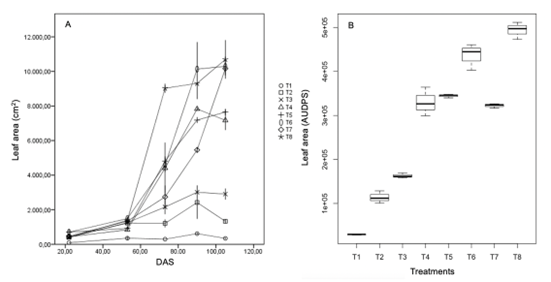
Figure 1. a) Mean values for Leaf area cm2; b) boxplot for AUDPS leaf area values for the whole cycle of the plant, measures made at 22, 53, 73, 90 and 105 days after sowing (DAS). Error bars correspond to standard deviation +/- 1. T1: 1.000kg ha-1 of chicken manure (CM); T2: 2.000 kg ha-1 CM; T3: 6.000 kg ha-1 CM; T4: mineral + 1.000 kg ha-1 CM; T5: mineral + 4.000 kg ha-1 CM; T6: mineral + 6.000 kg ha-1 CM; T7: 15 kg ha-1 of DAP,10.16 kg ha-1 of KCl and 5 kg ha-1 of urea; T8: 321 kg ha-1 of 10-30-10.
Sinks are net importers of assimilates and consist of rapidly growing organs such as meristems and immature leaves, and storage tissues such as tubers, seeds, or roots (Foyer & Paul, 2001). Nitrogen and potassium are known to increase the leaf area in potato crops (Kundu et al. 2019). In the case of organic manure, the N and K nutrients have low concentrations (>5 %) compared with a chemical source, these levels affect the leaf area in other crops like wheat (Limon-Ortega et al. 2008).
At 110 days after sowing (DAS) the accumulation of dry weight in shoots and tubers in the treatment with organic-mineral 6 Tons achieved the best dry weights; this behavior was followed by mineral fertilization and conventional fertilization (Figure 2). The increase of dry weight DW in treatments with conventional and mineral organic (6t) was much greater in AUDPS.
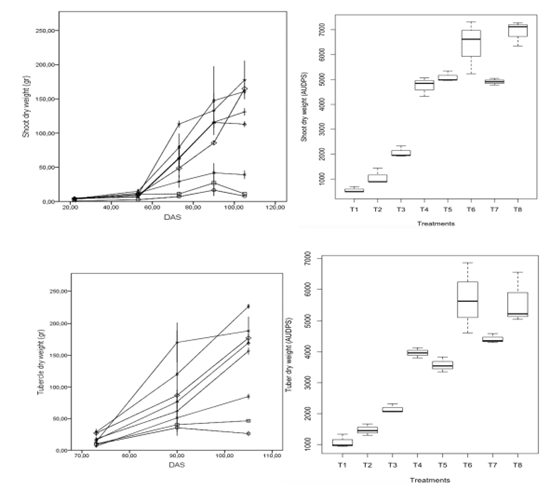
Figure 2. Dry weight (DW) of a) shoot and c) tubercle. Boxplot for AUDPS values of b) shoot and d) tubercle. Error bars correspond to standard deviation +/- 1. T1: 1.000 kg ha-1 of chicken manure (CM); T2: 2.000 kg ha-1 CM; T3: 6.000 kg ha-1 CM; T4: mineral + 1.000 kg ha-1 CM; T5: mineral + 4.000 kg ha-1 CM; T6: mineral + 6.000 kg ha-1 CM; T7: 15 kg ha-1 of DAP,10.16 kg ha-1 of KCl and 5 kg ha-1 of urea; T8: 321 kg ha-1 of 10-30-10.
Conventional (T7) and mineral mixed with 6 Tons of organic source (T6) treatments, obtained the best response in leaf DW (Figure 2a), this could be influenced by the high levels of nitrogen that induce vegetative growth, as seen in the leaf area (Figure 1). These results are related to the area values of AUDPS (Figure 2b) which confirms the best response of these treatments in the evaluated period.
The DW accumulation was faster in the period of 50 to 100 DAS corresponding to the periods of tuber formation and development; at the end of the season, the tubers accounted for 90 % of the total dry weight (Figure 2c).
For all treatments, the accumulation of DW in the tubers began after 58 DAS, with 65 % of the total DW. The organic treatment at 6 t of organic (T3), reached 88 g plant-1 of DW for tubers, while; the combination of mineral and organic fertilization at 6 t ha-1(T6) reached 230 g plant-1 of DW in tubers, being the highest in all treatments; the mineral and conventional treatments were close to 190 g plant-1.
The stabilization and subsequent fall of the growth curves represent the processes of cessation of biomass accumulation and translocation of nutrients to the sink organs. The results coincide with those of Soto Gárces et al. (2018) modeled by SUBSTOR. Similarly, S. tuberosum group phureja redistributes the nutrients through the translocation of these towards the storage organs, this was why at the end of the cycle a decrease occurs in the amount of biomass.
There were no significant differences (p-values <0.05) in the number of main stems until 112 DAS (Table 2), where the conventional treatment presented the highest number of main stems per plant; followed by mineral organic treatment of 4 t ha-1. On the other hand, the treatments with the lowest number of stems were organic with 1, 4, and 6 t ha-1 and the organic mineral of 1 t ha-1 (Table 2).
Table 2 Effect of different nutrition sources on the number of main stems in potato plants.

Treatments with a different letter are significantly different (p <0.05) accorded to Tukey’s honest significant difference (HSD) test.
One of the most relevant factors affecting the variable number of main stems per plant is plant density. The plant from seed tuber is formed by a set of aerial and underground stems and each stem grows and behaves as an individual plant. In this case, each of the treatments had the same number of plants, without significant differences. Therefore, observed differences can be attributed to the effects of the treatments, and not related to the competition between stems and source-sink relations.
Significant statistical differences (p-values >0.05) among treatments were found for stem length (Table 3). However, the differences depended on the sampling date. The application of chemical fertilizer and organic fertilizer did not present significant statistical differences, compared to the application of organic fertilizer alone.
It was found that the longest stem length was obtained by the organic mineral treatment of 4 t ha-1; followed by mineral treatment and organic mineral treatment of 6 t ha-1 with 78, 76 and 75 cm, respectively. Opposite the result of organic manure only, presented the worst results in stem length, being the organic treatment 1 t ha-1 with a value of 22.2 cm (Table 3).
The stem length variable was a very sensitive variable to evaluate, the behavior of each type of fertilizer. A decisive factor that can influence the better effect of chemical fertilization with organic fertilizers is by increasing organic matter and the cationic interchange capacity, especially Mg and P (Martínez-Alcántara et al. 2016). Similar results in the affection of stem length could be observed in S. tuberosum in plants stressed by drought (Chang et al. 2018).
Organic mineral fertilization produced similar yields compared to mineral and conventional ones (Figure 3a). However, within the organic-mineral treatment a clear tendency to increase yield with the chicken manure rate was observed, treatments established with 1, 4 and 6 t ha-1 of organic manure per hectare presented the lowest yields with values of 1.68 to 4.46 t ha-1. This agrees with Muñoz & Lucero (2008) who evaluated the effect of organic fertilization in ‘Criolla’ potato and found that the best relation was 2.200 kg ha-1 of chicken manure and 150 kg of 13-26-6 per ha. Zamora et al. (2008) reported 32 t/ha with organic fertilizers (goat manure).
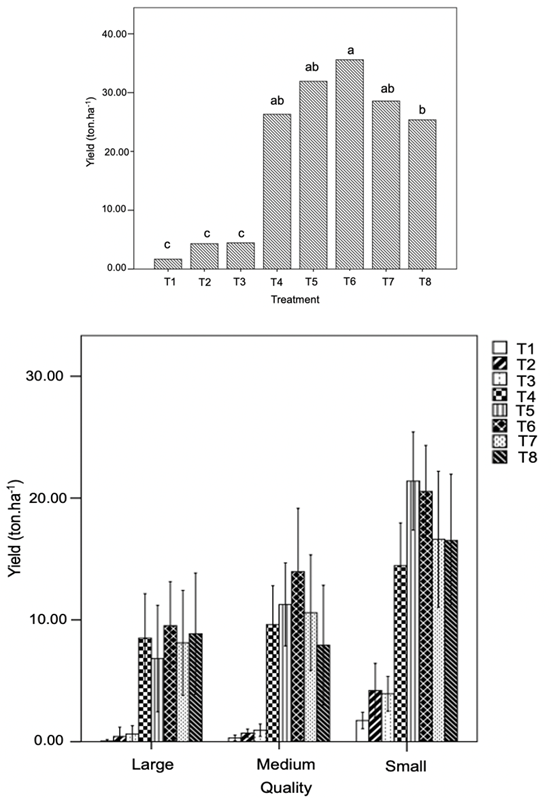
Figure 3. Potato yield (t ha-1), plants harvested at 120 days after sowing (DAS); b) Yield in Tons per hectare for qualities in each treatment, large (4-6 cm), medium (2-4 cm) and small (<2 cm). Columns with different letters were statistically different (p <0.05) according to Tukey’s honest significant difference (HSD) test. T1: 1.000 kg ha-1 of chicken manure (CM); T2: 2.000 kg ha-1 CM; T3: 6.000 kg ha-1 CM; T4: mineral + 1.000 kg ha-1 CM; T5: mineral + 4.000 kg ha-1 CM; T6: mineral + 6.000 kg ha-1 CM; T7: 15 kg ha-1 of DAP,10.16 kg ha-1 of KCl and 5 kg ha-1 of urea; T8: 321 kg ha-1 of 10-30-10.
In all treatments the predominant size was small (Figure 3b). Treatments with only organic manure showed the lowest values in the production of large and medium quality. On the other hand, the organic mineral treatments with 1 t of organic manure and the conventional treatment showed the highest production of large quality.
The effect of the combination of chemical and organic fertilizers is based on the improvement of the physicochemical properties of the soil and the gradual nutrient release by mineralization, favoring tuber quality and crop yield (Barrera B., 2004). Thus, organic fertilizer is an ideal companion for chemical fertilizers. In this regard Romero-Lima et al. (2000), in Mexico, found that when chicken manure was applied in potato crop soil, the external nutritional requirements were lower, higher quality tubers were obtained and yields were increased with the applications of organic mineral treatments.
The supply of nutrients at the right time has a marked influence on the number of tubers and their quality. ‘Criolla’ potato cultivation is a highly demanding crop for K, whose critical phase of absorption is very short; therefore, there must be good availability of this element for the plant to easily absorb it (Barrera B., 2004). Therefore, good availability of this nutrient is decisive for obtaining a high yield.
This agrees with the results obtained in the field, where the treatments with greater length of stem (Table 3) and higher yields (Figure 3a) are those of organic mineral fertilization with a contribution of 1, 4 and 6 t ha-1 of organic chicken manure, respectively.
Organic manure was not enough to allow the best response in all variables, other hand interactions with mineral nutrients, enhance the response of all variables and yield a response. However conventional treatment had the better response in the main variable for producers, yield.














